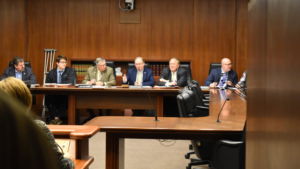Dayton Leaves Big MNLARS Mess Behind
He’s only a year and a half late. But even Gov. Dayton now admits the MNLARS vehicle registration system rolled out on his watch has been nothing short of “disastrous.” The latest appearance by Dayton’s team before an oversight committee left many lawmakers aghast this week again.
 It didn’t exactly enhance their credibility when the state’s top tech and public safety officials claimed that getting up to answering almost 60 percent of their calls and delivering one-third of 32,000 REAL ID license applications represents progress.
It didn’t exactly enhance their credibility when the state’s top tech and public safety officials claimed that getting up to answering almost 60 percent of their calls and delivering one-third of 32,000 REAL ID license applications represents progress.
“Eighteen months,” said Rep. Paul Torkelson (R-Hanska), co-chair of the [MNLARS Steering] Committee. “Are we more than halfway to the end of this story? Or do we have another 18 months to go?”
Almost certainly that much longer. A quarterly report released at the hearing lists more than 100 MNLARS technical flaws that still need to be fixed.
The team will transition to basic system support, and the application will not be staffed sufficiently to keep the fixes and new feature development progressing through the remainder of FY 2019.
There are 110 items remaining on the stakeholder priority Master List – 35 gaps, 56 defects, and 19 new feature requests that are not yet fully covered in the MNLARS Vehicle release plan. In addition, there remain several legacy systems that have not been migrated to the modern MNLARS Vehicle system, as well as many maintainability and stabilization/optimization features that would allow the system to be maintained properly post launch.
At the same time, the MN.IT and Public Safety commissioners warned that lack of adequate funding could jeopardize meaningful progress.
Ramping back up and transitioning to a new team, versus continuing system improvements with an experienced team, will cost more and lead to lost productivity.
As has been reflected in previous biennial budgets, there is not sufficient ongoing funding sources to support the maintenance of either the MNLARS Vehicle or FAST Driver systems. MNIT and DPS must secure funding for MNLARS to avoid impacting critical services upon which Minnesotans rely.
Left unsaid is that MNLARS has already cost more than double the original $48 million estimated price tag, crossing the $100 million threshold this year. But as a recent Star Tribune story practically screams, “Wait! There’s more!”
In all, the 174 local offices and licensing centers that deal with the public — called deputy registrars — were out about $9 million in the first year with MNLARS. And that number is growing, said Jim Hirst, a lobbyist for the Minnesota Deputy Registrar’s Association. “These transactions are just taking longer at the service centers,” Hirst said. “It’s not only the glitches and the gaps, but a lot of the data input and back-end work now has to be done upfront by the deputy registrars — which takes more time, which means longer lines, which means we have to hire more people.”
Gov. Dayton may be going away. But the problems he leaves behind with MNLARS aren’t going anywhere anytime soon.